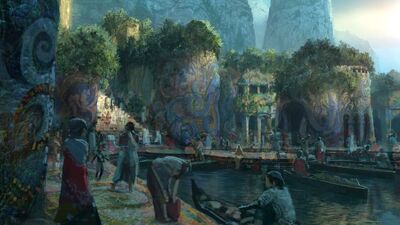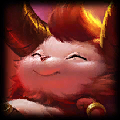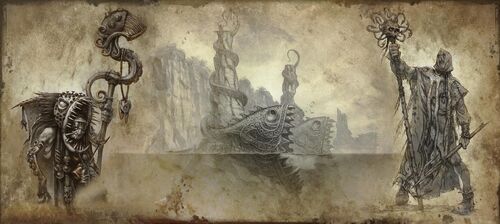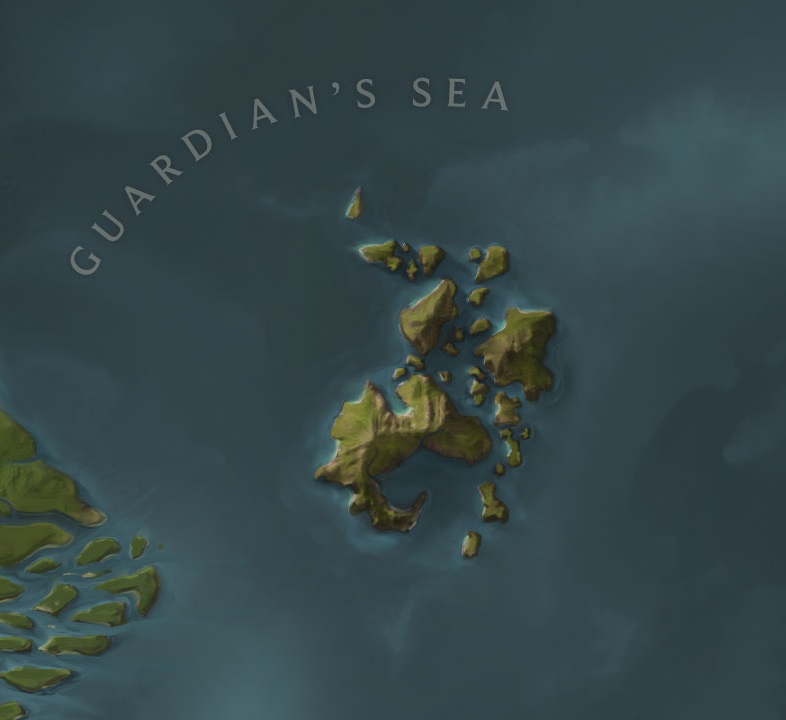
Buhru Temple
| “ | |
| — | |
Buhru is an island and coastal settlement which is part of the larger Serpent Isles.
Lore
The isle of Buhru are one of the isles of the Serpent Isles island chain,[1]. Here battle isn't considered a test of strength but of will.[2] These Isles are the location from which the religion of Nagakabouros and its originate from.
Champions of Buhru
Locations
- Temple of The Mother Serpent: The main Serpent Isles temple for the deity known as Nagakabouros.
Culture
While much of Valoran knows the archipelago as the Blue Flame Isles, to the indigenous people of Buhru they have only ever been the Serpent Isles. Buhru’s ancient culture is highly respected, reflected, and sometimes imitated in the daily life of Bilgewater—including traditional medicine, and monster hunting techniques.
The indigenous culture of the Blue Flame Isles is highly respected by the inhabitants of Bilgewater and aspects of it have been incorporated into daily life. The native peoples' knowledge of the ocean and its denizens is second to none; no ship is able to navigate the perilous straits around Bilgewater without their guidance. Those of indigenous descent often hold key roles in Bilgewater's fleets and gangs and are regarded with almost mystical reverence, as are the rare few embraced by their community.
There are several ancient languages spoken in Bilgewater and islands around it; one of which is spoken by priests of Nagakabouros from the Isle of Buhru, such as
(The ancient Buhru Illaoi uses is a mix between real life Nahuatl, Polynesian, and Mayan languages)
Buhru Language[3]
- Grammar
Buhru ['bʌh.ru] is an inflectional and agglutinative language, i.e. Buhru-speakers modify a word to express grammatical categories: like a noun's number, a verb's tense, etc. by adding affixes, yet roots and affixes almost always remain unchanged:
- Buhru's plural suffix is -i, e.g. yaotl [ja.otɫ̩] "enemy" > yaotli [ja.otli] "enemies"
Buhru has two grammatical genders:
- Feminine nouns typically ends with a vowel, like Llatoo [latu];
- Masculine nouns typically ends with clusters tl [tɫ̩] & chtl [ʃtɫ̩], occasionally c [s], e.g. yaotl
- (Nahuatl does not have grammatical genders, only two noun classes: animate and inanimate).
- (In Nahuatl, -tl ~ -tli ~ -li are absolutive singular suffixes, to mean that the noun is not possessed; e.g. yāōtl "enemy" vs. tēyāōuh "someone's enemy"; itzcuīntli [it͡skʷiːnt͡ɬi] "dog" vs. tēitzcuīn "someone's dog"; cal- + -tli = calli "house" [ka:li] vs. tēcal "someone's house")
- Phonotactics
Each Buhru syllable contains:
- an optional onset of one or more consonants, e.g. opochtli [o.po.ʃtli], whose syllables have all three structures V.CV.C⁺V;
- from Nahuatl ōpōchtli [ˈoː.poːt͡ʃ.t͡ɬi] "south", whose three syllables are actually structured V.CVC.CV; more here
- an obligatory nucleus of one vowel, e.g. oro, aco, ata, umo, buhru etc..
- Hiatus is allowed, so Buhru speakers may produce a sequence of vowels without intervening consonants: poao, uocae, etc.
- an optional ending of one or more consonants, e.g. chtl.
- Word Formation
Full words contain at least three syllables, e.g. Iccia "Eye’Sse’a." [aɪs.sia]
Adjectives, adverbs, and particles (analogous to Japanese honorific -san さん) are usually disyllabic, yet they often do not stand alone, but must accompany trisyllabic nouns, e.g. kaiya-oto Kai’Yah Oto [kaɪ.ja o.to].
The language is broken into two-syllable words, three-syllable words, and five-syllable words. Typically a single thought takes about twelve syllables.: “Kaiya-oto iccia, ohomoc-ata uotaca.”
- Punctuation
For longer words use a – (dash) if needed to signify a morpheme boundary. Never use an apostrophe ‘ (rare exceptions exist, like sa'eu).
- Orthography
Buhru possesses a deep orthography: a sound does not always correspond to the letter in a one-to-one fashion; for example: Y is pronounced like English "y" [j] in yaotl [ja.otɫ̩] but "sh" [ʃ] in Yaowc [ʃa.oʊs].
- Vowels
- “Ao” does not exist. Use “Oa” instead.
- “Ea” does not exist. Use “Ae” or “æ” instead.
- “E” letter does not exist. Replace with “AE” or ii (Sean = Siian).
- “X” sound does not exist.
- “Er” sound does not exist.
- “Ir” sound does not exist.
- “Ou” do not exist. Replace with “ua” or “u” (out = uat).
- "Oo" does not exist, except at the end of feminine words. (boot = Buot) (Llatoo).
- “Ai” sound very rare. Do not use this sound most times.
- “As” does not exist and is not used.
- “Y” is only used at the beginning of a word for the “eye” I sound.
- Consonants
- “K” is replaced by C.
- “M” is only used next to vowels and is never the beginning or end of a word.
- “S” is replaced by C. The S sound does not exist.
- “T” is never alone. Add another consonant. Tl, Tl, Tc, t…
- “Th” /θ/ sound does not exist. Do not use this sound.
- “H” is never used alone. (hr , htl etc..).
- “U” can be used as vowel or as consonant for V.
- “L” is never alone (The “L” sound is always long. IF using L Add another consonant.
- Ll, tl, lw, lc, ul, etc..).
- “Sh” does not exist and is not used.
- “V” letter does not exist. For sound replace with U.
- Be aware and avoid direct use of of Tl, Tc, cll, Chtl, Ythl, etc…
- Vocabulary
Words are built on combinations of real-life Aztec, with additional elements of Hawaiian, Maori, Aboriginal Australian, Ancient Greek, Latin, etc.
- Abulaccanii.
- Althabo.
- - Awaken to reason.
- Aocarzintli.
- Arzintli - Sacred water.
- Arzintli Qaoc.
- Ata.
- Atha.
- Bauhro Laidahcii.
- Bradhuc Ladcii.
- Bru-ahcci Lahdi.
- Buahdacci.
- Buara Dalii.
- Buzulduac.
- Burahdatc Lacbi.
- Caolz.
- Chodatc.
- Coatl.
- Colotl.
- Ctamacihtol.
- Cuatl.
- Curi.
- Ghiara.
- Guhra Ctaoc (Gow’rah Shaos).
- Guyra.
- Ictae.
- Ibuhr.
- Illaoi.
- Illuka.
- Illuora.
- Ioelu.
- Ioilu.
- Iwtia.
- Kaiha.
- Kaiya.
- Lcaoc.
- Nlaepin.
- Nura.
- Oalhauchtli.
- Octala.
- Octulu.
- Ohlaoc.
- Omu.
- Opochtli.
- Oqul.
- Oto.
- Otomoc.
- Owaimoc.
- Ozoac.
- Ozomoc.
- Poao.
- Qo-a xoas.
- Qo-a Yegu.
- Qo-uto.
- Qaoc Cuatl.
- Qalotl.
- Qoachitli.
- Qoasotl.
- Qtocaotl.
- Rava Ocllo.
- Rava Ucllo.
- Sa’eu.
- Sa-iu.
- So Aolo
- Taepl.
- Tjorrah.
- Tlaco.
- Tlatha.
- Tua.
- Tuamaz.
- Ubrucii.
- Ucanu.
- Ulioc.
- Upali.
- Uqioc.
- Uwan Yaowc (Oo’wan Shaos)
- Vae-a.
- Vaia.
- Xaiv.
- Xaoc Guhra.
- Xoas.
- Xoco.
- Yaotl - Enemy.
- Yaotli - Enemies.
- Yllacta.
- Yulutl.
- Yuotldii Lahyi.
- Yuralha.
- Yurochtl.
- Yutu.
- Zocua.
Nagakabouros
| “ | |
| — | |
Central to Buhru culture is Nagakabouros—god of life, growth, and perpetual motion. Also known as the Mother Serpent, the Great Kraken, or the Bearded Lady, she is commonly depicted as an enormous, monstrous head with many spiraling tentacles.
When arriving in and leaving port, sailors throw offerings overboard in the hope of quelling her wrath. Myths about her date back centuries, and it's a reckless sailor who fails to drop the traditional tithe into the Serpent's Well upon docking his ship in Bilgewater.
, the Goddess' priestess, tests weaklings and the dead to see if they pass Nagakabouros's judgement. The Goddess directly intervened in one of the recent Harrowings to stop the Black Mist from destroying the entire city of Bilgewater.Relations
Ixtal
Ixtali culture is part of a older great westward diaspora that gave the rise of civilizations such as the Buhru of the Serpent Isles. After its isolation from the rest of the world and the formation of Bilgewater, a lot of pirates and adventure seekers would attempt to trek into the unforgiving jungle landscape in search of ancient treasure, only to never be heard from again (due to the wildlife, or the Ixtali defending their borders). One of the group of people that settled the regions around Ixtal are the riverfolk of the Serpentine River.
Media
See Also
References
- ↑ Origin of the Martyr's Gambit
- ↑ Flavor text of Martyr's Gambit
- ↑ Buhru Language








